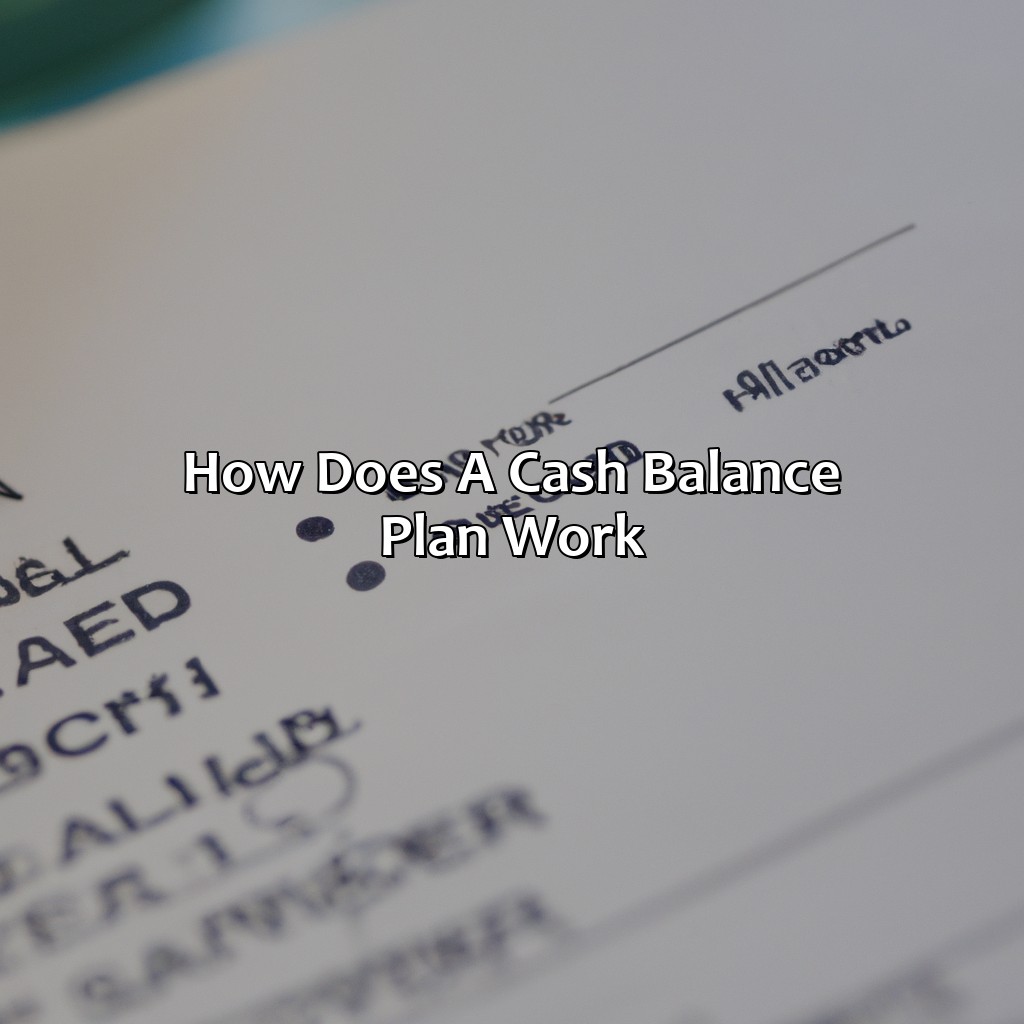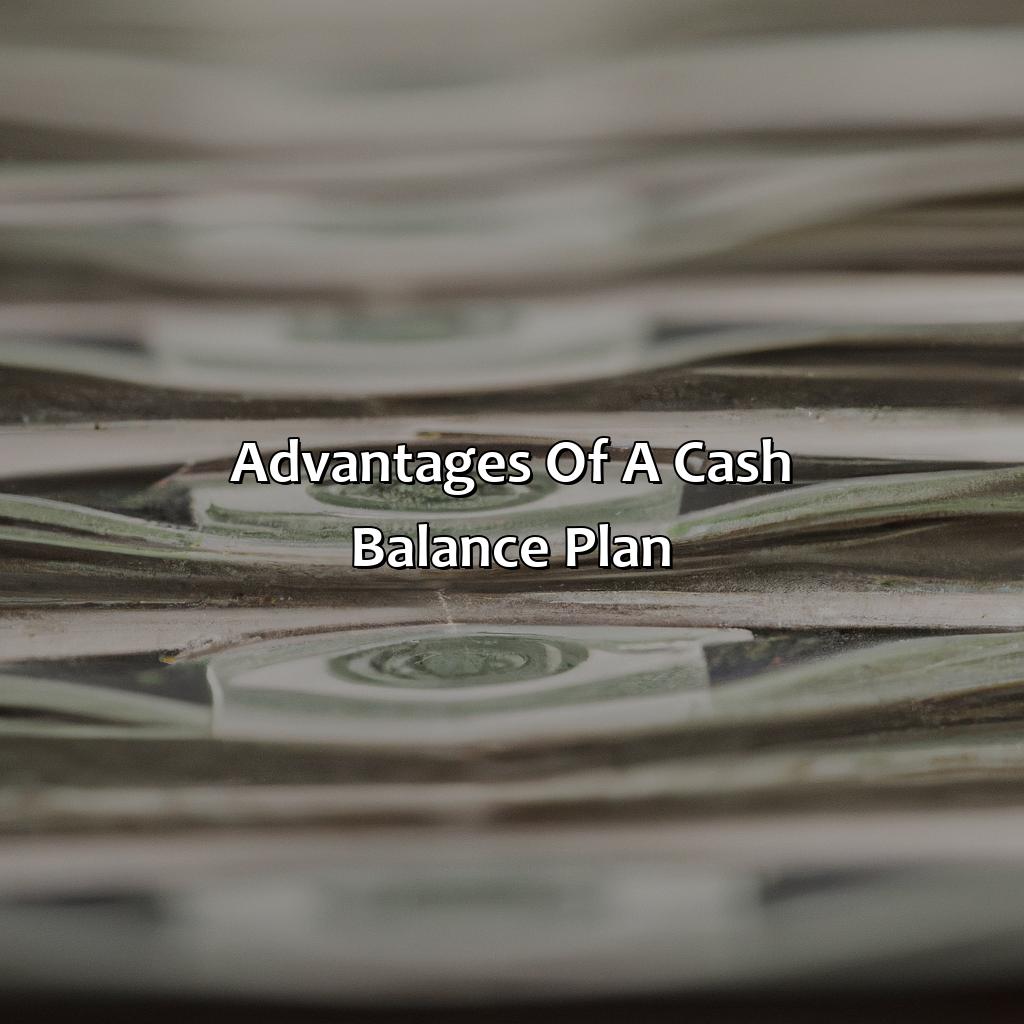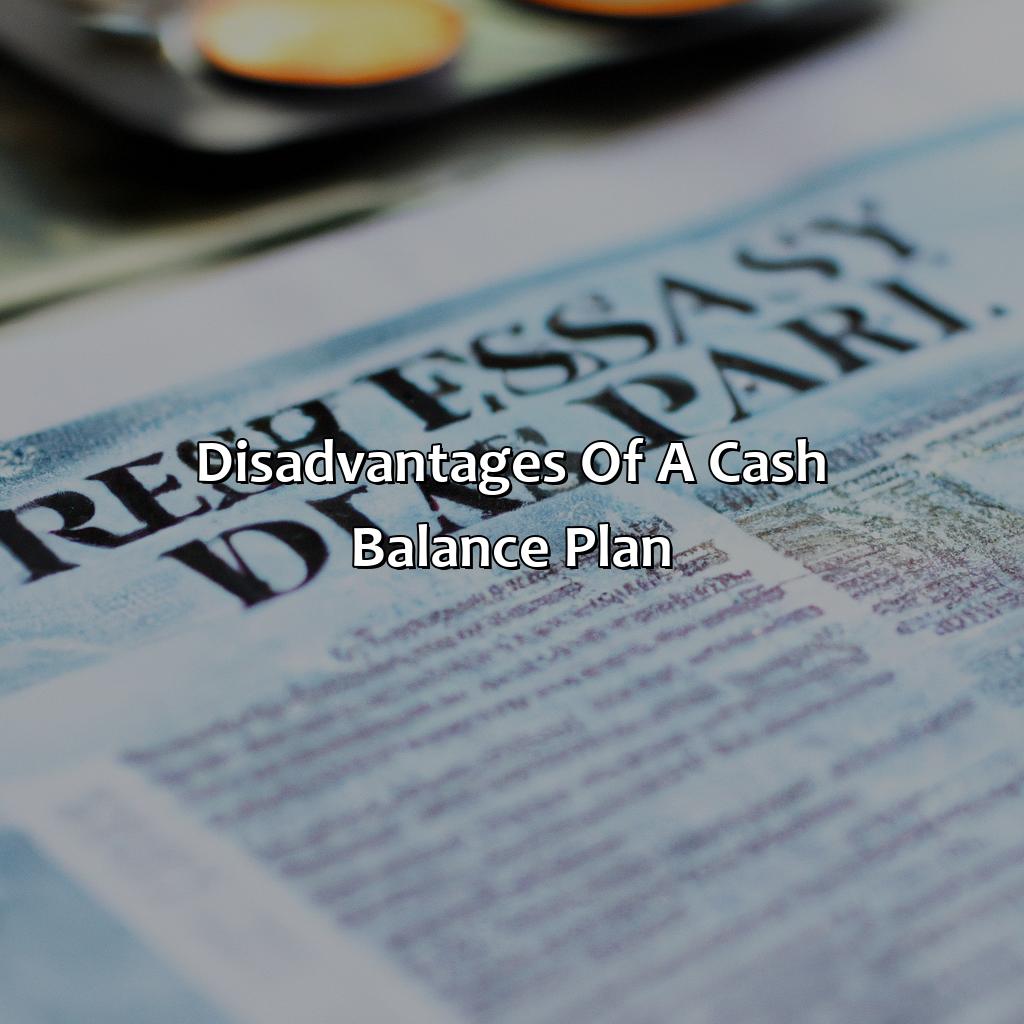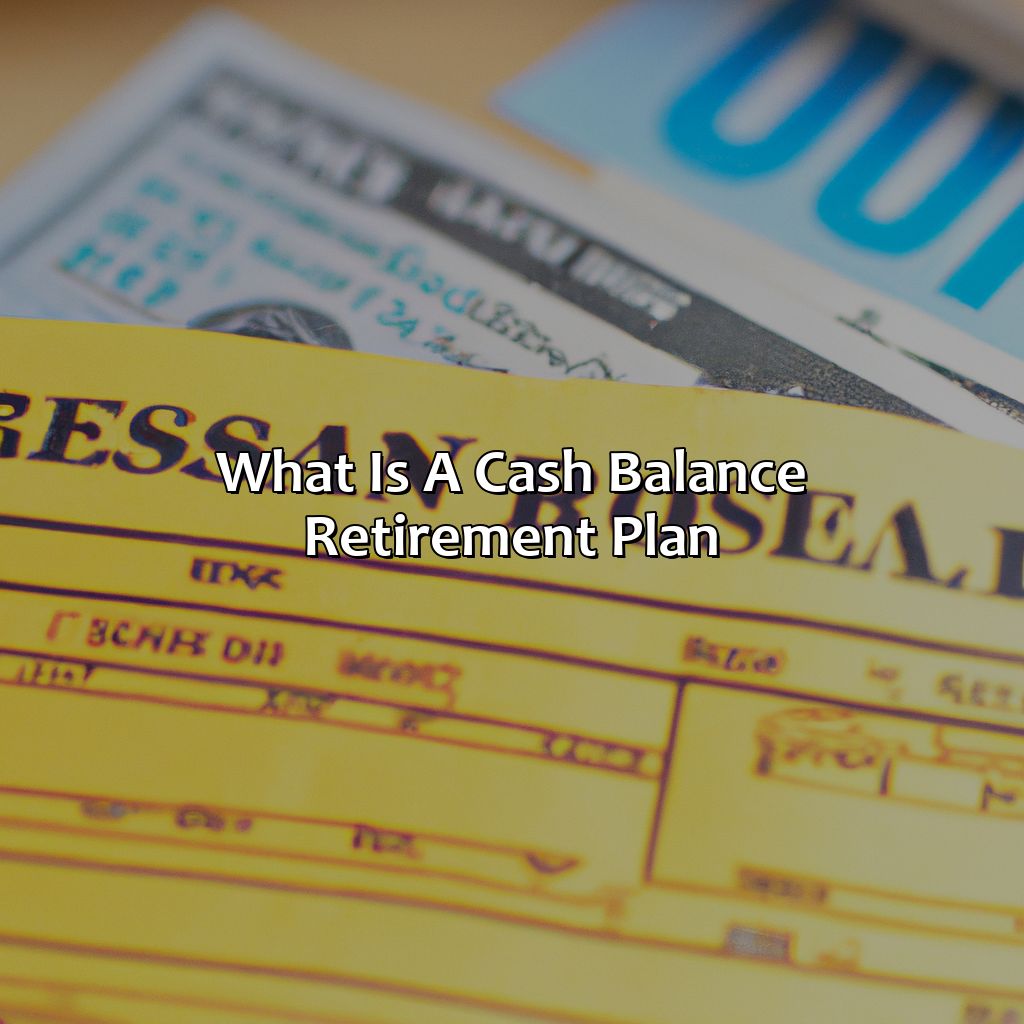What Is A Cash Balance Retirement Plan?
Key Takeaway:
- A cash balance retirement plan is a type of defined benefit plan that is becoming increasingly popular among employees and employers. It allows for predictable retirement savings and higher contribution limits than traditional IRAs and 401(k)s.
- In a cash balance retirement plan, contributions are made by the employer and interest credits are added to the account balance. At retirement, the participant receives a benefit calculation based on their account balance.
- While there are advantages to a cash balance plan, such as portability and predictable retirement savings, there are also disadvantages, such as potentially high administrative costs for employers and limited investment options for participants.
Do you want to ensure financial security in your retirement? A Cash Balance Retirement Plan can help you save money and maximize your retirement income. You deserve secure and reliable retirement planning, and this article will explain how a Cash Balance Retirement Plan can help you achieve it.
What is a Cash Balance Retirement Plan?
To comprehend cash balance retirement plans, one must delve into the section ‘What is a Cash Balance Retirement Plan?’ It has sub-sections like:
- ‘Definition of a Cash Balance Plan’
- ‘Differences between Cash Balance and Traditional Pension Plans’

Image credits: retiregenz.com by Joel Jones
Definition of a Cash Balance Plan
Cash balance plan is a type of retirement plan where an employer contributes a specified amount to an employee’s account each year. The plan typically guarantees a minimum interest rate and benefit upon reaching retirement age. This can be considered as an alternative to traditional defined benefit plans. The benefit formula is based on a hypothetical account balance that represents the sum of annual employer contributions and credited interest, with adjustments for any benefits paid out or forfeited.
Furthermore, cash balance plans offer portability, allowing employees to take their vested benefits with them in case they change jobs. They are becoming more popular among small businesses due to their predictable costs.
According to The Pension Protection Act of 2006, cash balance plans must meet certain requirements to ensure fairness for older workers. These include transitional rules providing special protection for long-term employees whose prior plan was terminated or converted to a cash balance plan.
It is important to note that not all retirement plans are suitable for everyone, and it is wise to consult a financial advisor before committing to any plan.
Why settle for a traditional pension when you can have a cash balance plan and retire like a boss?
Differences between Cash Balance and Traditional Pension Plans
Cash Balance plans, unlike traditional pension plans, provide employees with individual retirement accounts with a set amount annually. Below is a detailed table illustrating the differences between the said plans.
| Category | Cash Balance Plan | Traditional Pension Plan |
|---|---|---|
| Funding | Employer-funded | Co-funded |
| Benefit Accrual | Variable: Based on planned contribution and interest rate guarantees guaranteed by employer or insurance firm. | Fixed formula, typically based on years of service and final salary. |
| Benefits Received Upon Retirement or Termination | Can receive lump sum (rollover to an IRA) or annuity payments (monthly) over a period of time. | Typically offers fixed monthly payments for employee’s life post-retirement. |
It’s important to note that Cash Balance plans are usually more portable than Traditional Pension Plans because they allow employees to roll over payments into individual retirement accounts quickly. This can be advantageous in situations where employees move from one organization to another or become self-employed.
If you are considering setting up a retirement plan for your business, it’s always better to consult with a financial advisor to select the right plan according to your company goals and objectives. They will help you understand the risks and benefits of each plan type and guide you through your decision-making process.
Cash balance plans: because 401(k)s just aren’t confusing enough.
How does a Cash Balance Plan Work?
To grasp a cash balance retirement plan, you must be aware of its significant components – contributions, interest credits, and benefit calculation. Together, these three factors decide the retirement benefit you get from your employer.
In this section, we’ll examine the advantages and operations of a cash balance plan. We have these subsections to help you understand better:

Image credits: retiregenz.com by Adam Jones
Contributions
This section pertains to the amount and frequency of contributions made in a cash balance retirement plan.
- Employer contributions are typically mandatory and a set percentage of employee salaries.
- Employees can also choose to make voluntary contributions up to IRS limits.
- Contribution amounts can be adjusted annually based on plan performance and actuarial assumptions.
It is important to note that contribution limits for cash balance plans differ from traditional 401(k) plans.
In contrast, numerous businesses have experienced significant savings and enhancements in recruitment because of implementing cash balance plans. For example, Company X observed an overall increase in staff morale due to professional growth opportunities created by these plans.
Interest credits: the only time your boss will be happy to give you more money for doing nothing.
Interest Credits
Cash balance plans distribute ‘annual interest credits’ to employees, typically based on a fixed or variable interest rate. This is an important aspect as the interest credit is added to each participant’s account balance at year-end, increasing their retirement savings.
The interest credit can be calculated in several ways, including a flat rate, a percentage of the employee’s salary, or based on a predetermined investment performance benchmark. The employer bears all investment risks and rewards in cash balance plans instead of employees. This means that any profits or losses come directly from the employer.
One unique detail is that if an employee leaves before reaching retirement age, they may have several options for handling their vested benefits. One choice would be to roll it over into another qualified retirement plan or take the present value of their accrued benefits.
According to Forbes.com, Cash balance plans have become increasingly popular among small business owners because they allow them to save significantly more for retirement than traditional 401(k) contributions.
Calculating your retirement benefits has never been this suspenseful, it’s like waiting to find out if the cash balance plan lottery numbers match your retirement dreams.
Benefit Calculation
A fundamental aspect of a cash balance plan is determining how to calculate the retirement benefits.
- The amount contributed by employees and employers determines the fund balance.
- An interest rate, fixed or variable, may be added annually to the account balance.
- Each year, an employer must credit interest to the account on behalf of each participant that builds on the employee’s benefit balance.
- A defined benefit plan guarantees a set payment amount upon retirement; cash balance plans determine an account balance guarantee.
- Cash balance pensions compute annual retirement benefits as either a percentage of future income or a dollar amount.
Lastly, it is important to note that unlike traditional pension plans, cash balance plans have higher contribution limits for those closer to retirement age.
According to Investopedia.com, “Cash Balance Pension Plan: An Overview” – These types of pensions may provide significant tax advantages for small business owners.
Who needs a traditional pension plan when you can have a cash balance plan and actually know what your retirement savings are worth?
Advantages of a Cash Balance Plan
Do you want to know the benefits of a Cash Balance Plan for retirement? It has predictable savings, higher contribution limits, and it’s portable. Read on for more info!
Here’s why a Cash Balance Plan is better than other retirement plans. Could it be the right choice for you? Find out!

Image credits: retiregenz.com by Adam Arnold
Predictable Retirement Savings
Retirement planning can be daunting, but a cash balance retirement plan offers predictable savings. It provides participants with a guaranteed interest rate of return and annual contributions from their employer. The plan also has flexible contribution limits, making it an attractive option for high-income earners seeking to increase their retirement savings.
Furthermore, the benefits of a cash balance plan are transferable if the participant changes jobs or retires early. These plans are subject to government regulations and must be managed by a fiduciary.
In addition, according to Forbes magazine, in 2021 “More than ever before, small businesses are adopting cash balance pension plans as key pieces of their retirement program’s puzzle.”
It is essential to do your research and consult with a financial advisor to determine if a cash balance retirement plan is the right fit for your financial goals and needs.
Saving for retirement is like playing a game of limbo, but with cash balance plans, you can bend over backwards and still come out ahead with higher contribution limits.
Higher Contribution Limits than Traditional IRAs and 401(k)s
Cash balance retirement plans provide greater financial benefits than traditional IRAs and 401(k)s. With the former, individuals have the potential to contribute higher amounts towards their retirement savings, leading to better financial security post-retirement.
The contribution limit for cash balance plans is much higher than that of traditional IRAs and 401(k)s. Employers generally contribute a predetermined fixed dollar amount or a percentage of an employee’s salary annually to the plan. Additionally, these plans also allow for catch-up contributions once an individual is over the age of 50.
Higher contribution limits enable employees to accumulate substantial savings in a relatively short period of time. The table below shows a comparison between contributions made to different retirement plans.
| Type Of Plan | Maximum Annual Contribution |
|---|---|
| Traditional IRA | $6,000 (age <50) $7,000 (age ≥50) |
| 401(k) | $19,500 (age <50) $26,000 (Age ≥50) |
| Cash Balance Plan | Up To $230,000(Age <50) |
Moreover, cash balance plans are attractive to employees with shorter expected tenure because they offer significant benefits without the same vesting requirements as other similarly sized defined benefit plans. This can help employers attract top talent while providing valuable benefits packages.
As retirement planning becomes more important in today’s world where life spans continue getting longer and medical costs continue skyrocketing, it’s essential to take full advantage of available options like cash balance plans that offer superior benefits. Don’t miss out on this unique opportunity and speak with your employer today about incorporating one into your future! Who needs a gym membership when you can get your daily workout lugging around your portable cash balance plan?
Portability
One of the key benefits of a cash balance retirement plan is its transferability. This feature allows employees to take their account balance with them when switching jobs or retiring early. Upon separation, they can choose from several options such as rolling over the funds into an individual retirement account (IRA) or another employer’s qualified plan. The portability feature also favors high-income earners who often change jobs frequently, increasing their chances of accumulating significant savings in their accounts.
Additionally, the ability to receive a lump-sum distribution of the accrued benefits upon separation is another advantage this plan offers. This feature gives employees greater flexibility and control over their retirement funds and helps them make informed financial decisions without necessarily restricting them to specific investment options.
Pro Tip: It’s essential to work with a financial advisor who understands this type of plan and provides guidance on investment options, contribution limits, tax implications, and potential risks associated with rolling over or leaving your assets in a cash balance plan after separation.
Unfortunately, not everyone can handle the pressure of having unlimited access to their retirement savings, but hey, at least they won’t have to worry about running out of cash for bingo night.
Disadvantages of a Cash Balance Plan
To get a handle on the cons of a cash balance retirement plan, let’s look at the negatives. We’ll focus on:
- The expenses employers may face when running this type of account
- The limited investment choices for participants

Image credits: retiregenz.com by Adam Washington
May be Costly for Employers to Administer
A Cash Balance Plan may pose a significant financial burden on employers due to its high administrative costs. The complexities surrounding the plan’s design, implementation, and maintenance require extensive expertise and professional support.
Further, the plan’s actuary must continually assess and update its assumptions and calculations, which requires additional time and resources. Employers may also face legal risks if they fail to comply with IRS requirements or provide incorrect information.
To mitigate these costs, employers may consider outsourcing their Cash Balance Plan administration to retirement plan consulting firms or hiring additional staff with specialized expertise. These solutions can free up internal resources and ensure compliance while reducing costs.
Employers should also collaborate closely with their plan administrators to streamline reporting processes and identify any potential cost-saving measures like reducing participant communication costs or implementing automatic enrollment. By paying close attention to the financial impact of their plan design choices, employers can ensure that they are maximizing their retirement benefits for employees while minimizing the overall cost of administration.
Looks like the only investment option in a cash balance plan is to invest in a stress ball to squeeze out your frustration.
Limited Investment Options
A cash balance retirement plan may limit the investment options available to employees. The plan usually invests in fixed-income securities, which offer low returns and are susceptible to inflation risk. This can leave employees with limited diversification and potential growth opportunities.
Moreover, these limited investment options also have an impact on the overall portfolio risk and return. As the plan invests primarily in fixed-income securities, it may not be suitable for workers with a longer time horizon or those seeking higher returns.
However, some plans offer more flexibility with investment options, such as allowing participants to choose certain mutual funds or exchange-traded funds (ETFs). It is essential for employees to evaluate their retirement needs and determine if a cash balance plan’s investment options align with their goals.
Employees who overlook alternative plans with better diversification and potential returns may miss out on opportunities to maximize their retirement savings. Consider consulting a financial advisor before selecting a retirement plan that suits each individual’s unique situation.
Five Facts About Cash Balance Retirement Plans:
- ✅ A cash balance retirement plan is a type of defined benefit plan. (Source: Investopedia)
- ✅ Employers contribute to an employee’s account through annual credits and interest. (Source: The Balance)
- ✅ Cash balance plans offer portability, allowing employees to roll over their account into an IRA or another employer’s retirement plan. (Source: 401(k) Specialist)
- ✅ These plans provide a guaranteed benefit amount at retirement, rather than depending on investment returns. (Source: IRS)
- ✅ Cash balance plans can have higher contribution limits than traditional 401(k) plans. (Source: Forbes)
FAQs about What Is A Cash Balance Retirement Plan?
What is a cash balance retirement plan?
A cash balance retirement plan is a type of defined benefit plan that operates like a hybrid between a traditional pension plan and a defined contribution plan. In a cash balance plan, the employer promises to pay a set benefit in retirement, and the employee receives annual credits to their account based on a specified percentage of their salary. As with a traditional pension plan, the employer is responsible for investing the assets in the plan.
How does a cash balance plan work?
In a cash balance plan, your employer sets aside a percentage of your salary each year as a “benefit credit.” This benefit credit is typically a percentage of your salary, such as 5% or 6%. Over time, these benefit credits accumulate in your account with interest. When you retire, you have the option to take your accumulated balance as a lump sum or as an annuity.
Who is eligible for a cash balance plan?
Cash balance plans are usually offered by employers and are designed to benefit older employees who are nearing retirement. They are often used as a primary or supplemental offering in addition to a 401(k) plan. Eligibility criteria will vary by employer and plan, so check with your employer’s HR department to see if you’re eligible.
Are there any contribution limits for cash balance plans?
Cash balance plans have similar contribution limits to traditional 401(k) plans. In 2021, the maximum contribution limit for employees is $58,000 or 100% of their salary, whichever is less. Additionally, the amount that can be accrued each year in a cash balance plan is limited to the lesser of 100% of the employee’s compensation or $230,000 in 2021.
What are the advantages of a cash balance plan?
Cash balance plans offer several advantages over other retirement plans, including predictable retirement benefits, portability, and creditor protection. Unlike a 401(k) plan, your retirement benefits in a cash balance plan are generally guaranteed and will not fluctuate with the financial markets. Also, if you leave your employer, you can take your vested balance with you.
What are the disadvantages of a cash balance plan?
One disadvantage of a cash balance plan is that they are typically less flexible than other retirement plans. Once you reach retirement age, you generally have limited options for accessing your funds. Also, the employer is responsible for making all investment decisions with the plan assets, so you have no control over how your money is invested. Lastly, if you leave your employer before your plan is fully vested, you may lose some or all of your retirement benefits.


